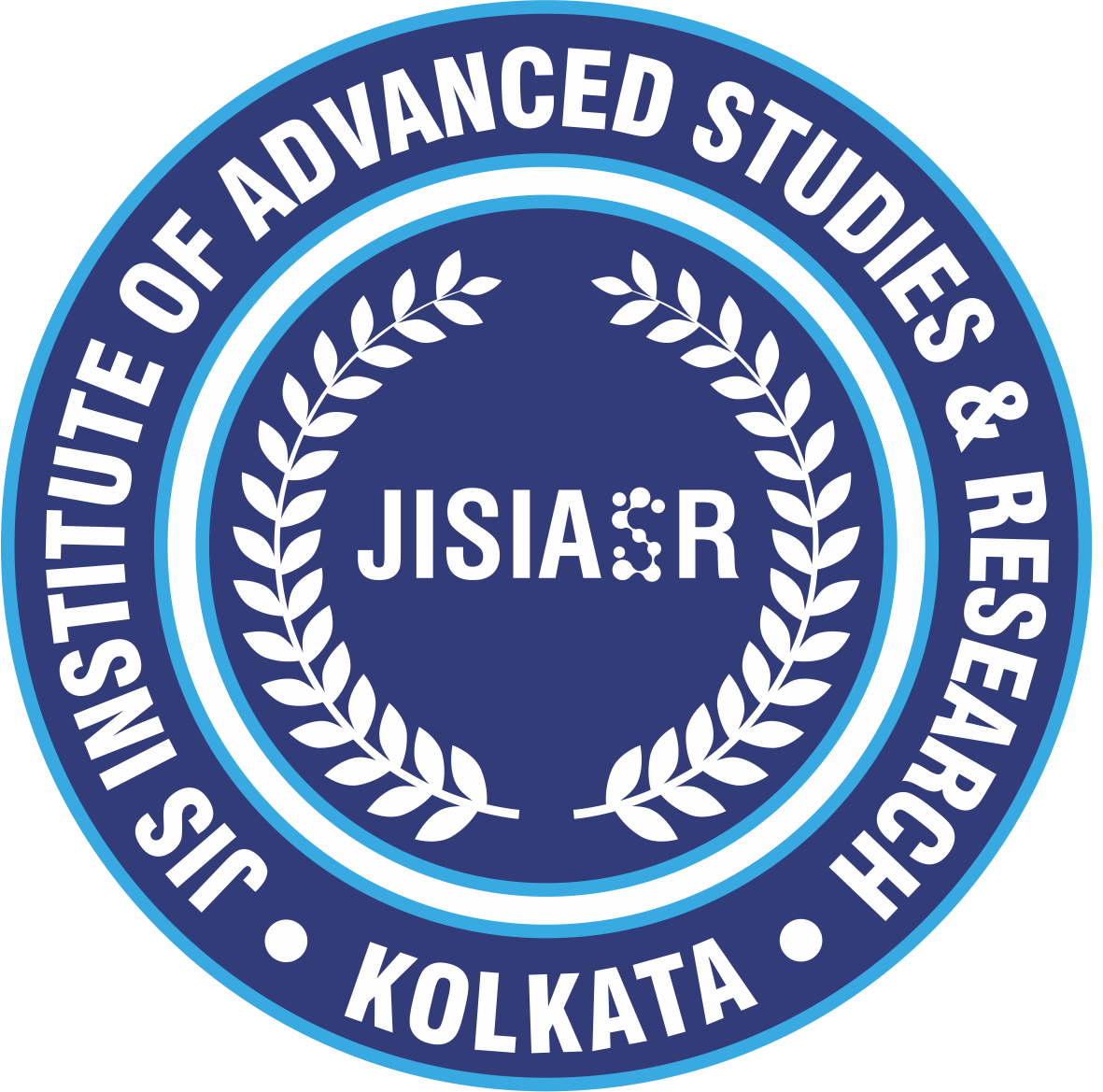Associate Professor
Ramalingaswami Fellow
Centre for Health Science & Technology
Email: debabani@jisiasr.org
Google scholar: https://scholar.google.com/citations?user=P6UTn6QAAAAJ&hl=en
Postdoctoral Fellow, Department of Biochemistry and Molecular Biophysics, Kansas State University, Manhattan, Kansas, USA
Ph.D., Department of Chemistry, University of Calcutta, Kolkata, India
Professional Engagements:
2021 – Present: Associate Professor & Ramalingaswami Fellow, JIS Institute of Advanced Studies and Research Kolkata
2019 – 2021: Assistant Professor & Ramalingaswami Fellow, JIS Institute of Advanced Studies and Research Kolkata
2014 – 2019: Ramalingaswami Fellow, Indian Institute of Engineering Science and Technology, Shibpur, WB, India
Feb 2014 – April 2014: Senior Research Associate (CSIR Scientists’ Pool Scheme), Centre for Research in Nanoscience and Nanotechnology, University of Calcutta, Kolkata, India
2007 – 2013: Postdoctoral fellow, Department of Biochemistry and Molecular Biophysics, Kansas State University, Manhattan, Kansas, USA
Research Topics:
Protein-protein and protein-ligand interactions, Structure and dynamics of intrinsically disordered proteins and couple folding and binding mechanism. Mutation and post-translational modifications of dieases related proteins, atomistic and coarse-grain simulation self-assembly of small peptides
Research Focus:
My research interest comprises of the theoretical and computational studies of structure, function and dynamics of bio-macromolecules, which have diverse cellular functions. We use molecular modeling and simulations to elucidate thermodynamics and kinetics of functional proteins, called “intrinsically disordered proteins” (IDPs), which are unstructured under physiological conditions. These are very important for cell signaling, signal transduction, regulation, and the cause of lethal human diseases hence important for drug discovery. Because of the heterogeneous and dynamical nature, molecular modeling is necessary to provide the missing details of disordered states of IDP that are crucial for understanding their functions, but cannot be captured by experiments. Using molecular modeling and simulation we have studied the structural and dynamical properties of IDPs. Key lessons from our research help to explain some of the biological roles of IDPs, which may lead to develop novel strategies for drug discovery.
1. Interdependency of post-translational modifications on terminals of tumor suppressor p53
Among the various types of PTMs, phosphorylation and acetylation of tumor suppressor protein p53 lead to stabilization and activation. It has been noted experimentally that phosphorylation often regulates acetylation at specific sites, which is also reduced by the phosphorylations. Mutations of phosphorylations sites to Alanine enhance and to Aspartic acid reduce the acetylations. We focus to study the effect of PTM on C-terminal of p53. The aim is to find how the presence or absence of phosphorylation favors or disfavors the acetylation using molecular dynamics simulation.
2. Role of post translational modifications on p53 binding
Phosphorylation at N-terminal domain of p53 increases binding affinity for Taz2 whereas this modification disrupts MDM2 binding, both of which are regulatory proteins essential for p53 functions. We are using molecular modeling to investigate how phosphorylation of both p53 complexes (with Taz2 and MDM2) regulates such binding diversity.
3. Effect of phosphorylation on PAR1
MARK/Par1 adopts the active and inactive conformations upon phosphorylations. This ‘active’ conformation is likely to be stabilized by the charge interaction between RD motif (174-175, conserved in catalytic loop, an arginine followed by catalytically active aspartate) and the phosphorylation site. The main thrust area of this project is to study the conformational ensembles important for the active and inactive forms and the specific role of the residues involved towards MARK/Par1 activity with the aid of molecular modeling and molecular dynamics simulation.
Book Chapter
1. Debabani Ganguly and Chaitali Mukhopadhyay, Recent Progress in Medicinal Plants: Globalisation of Herbal Health, Editors: Anil K. Sharma, V.K. Singh, J.N. Govil, and N.K. Goyal. Studium Press, LLC, Houston, Texas, USA. (Book Chapter) 12, 403-412 (2006) Oligosaccharide Recognition by Ricin B.
Journal Publications
1. Anamika Ghosh and Debabani Ganguly, JBSD DOI: 10.1080/07391102.2023.2279270 (2023) Structural impairment of p53 C-terminal due to the effect of phosphorylation and acetylation: A study on the interdependence of PTM.
2. Manas Bandyopadhyay, Sayan Bhadra, Swastik Pathak, Anila Menon, Deepak Chopra, Snehangshu Patra, Jorge Escorihuela, Souradeep De, Debabani Ganguly, Suman Bhadra, Mrinal K Bera, J. Org. Chem. 88, 15772 – 15782 (2023) An Atom-Economic, Metal-Free Method for 1,2,3-Triazole Derivatives via Oxidative [3+2] Cycloaddition Harnessing the Power of Electrochemical Oxidation and Click-Chemistry.
3. Rumpa Sarkar, Surya Kanta Samanta, Anila M. Menon, Deepak Chopra, Debabani Ganguly and Mrinal K Bera, Synthesis 55, 3303 – 3314, (2023) Synthesis of quinoline and quinolin-2(1H) one derivatives via nickel boride promoted reductive cyclization.
4. Surya Kanta, Samanta, Rumpa Sarkar, Utsav Sengupta, Sayan Das, Debabani Ganguly, Avantika Hasija, Deepak Chopra, and Mrinal K Bera, Org. Biomol. Chem. 20, 4650-4658 (2022) A direct entry to polycyclic quinoxaline derivatives via I2-DMSO mediated oxidative decarboxylation of α-amino acids and the subsequent Pictet–Spengler cyclization reaction.
5. Rumpa Sarkar, Surya Kanta Samanta, Avantika Hasija, Deepak Chopra, Debabani Ganguly and Mrinal K Bera, New J. Chem. 46, 7168–7176, (2022) A practical route to arylated dihydroacridine derivatives via nickel boride mediated intramolecular reductive cyclization-concomitant dehydration.
6. Anamika Ghosh and Debabani Ganguly, JBSD 41, 176-185 (2023) Structural modulation of p53TAD1-TAZ2 complex upon mutations and post-translational modification.
7. Souvik Misra, Soumyajit Mukherjee, Anamika Ghosh, Pijush Singh, Sanjoy Mondal, Debes Ray, Gorav Bhattacharya, Debabani Ganguly, Alok Ghosh, V. K. Aswal, Ajit K. Mahapatra, Biswarup Satpati, Jayanta Nanda, Chem. – Eur. J. 27, 16744–16753, (2021) Single amino-acid based self-assembled biomaterials with potent antimicrobial activity.
8. Susmita Das, Anindita Paul, Debbethi Bera, Abira Dey, Ahitagni Roy, Avisek Dutta, Debabani Ganguly, Mater. Today Commun. 28, 102672 (2021) Design, development and mechanistic insights into the enhanced antibacterial activity of mono and bis-phosphonium fluoresceinate ionic liquids.
9. Rachana Banerjee, Kausik Basak, Anamika Ghosh, Vyshakh Rajachandran, Kamakshi Sureka, Debabani Ganguly, Sujay Chattopadhyay, Infect. Genet. Evol. 92, 104874, (2021) Spike protein mutational landscape in India during the complete lockdown phase: Could Muller’s ratchet be a future game-changer for COVID-19?
10. Atanu Maity, Souvik Sinha, Debabani Ganguly, Shubhra Ghosh Dastidar, Phys. Chem. Chem. Phys. 18, 24095-24105 (2016) C-Terminal Tail Insertion of Bcl-xL in Membrane Occurs via Partial Unfolding and Refolding Cycle Associating Microsolvation.
11. Debabani Ganguly and Jianhan Chen, PLoS. Comput. Biol. 11, e1004247, (2015) Modulation of the Disordered Conformational Ensembles of the p53 Transactivation Domain by Cancer-Associated Mutation. [*
12. Hongzhou Huang, Debabani Ganguly, Jianhan Chen and Xiuzhi S. Sun J. Nanosci Nanotech 15, 4470-4479 (2015) Conformational Flexibility and pH Effects on Anisotropic Growth of Sheet-Like Assembly of Amphiphilic Peptides.
13. Debabani Ganguly, Weihong Zhang and Jianhan Chen, PLoS. Comput. Biol. 9, e1003363 (2013) Electrostatically Accelerated Encounter and Folding for Facile Recognition of Intrinsically Disordered Proteins.
14. Debabani Ganguly, Steve Otieno, Brett Waddell, Luigi Iconaru, Richard W. Kriwacki, and Jianhan Chen, J. Mol. Biol. 422, 674-684 (2012) Electrostatically Accelerated Coupled Binding and Folding of Intrinsically Disordered Proteins.
15. Weihong Zhang, Debabani Ganguly and Jianhan Chen, PLoS. Comput. Biol. 8, e1002353 (2012) Residual Structures, Conformational Fluctuations, and Electrostatic Interactions in the Synergistic Folding of Two Intrinsically Disordered Proteins.
16. Debabani Ganguly, Weihong Zhang and Jianhan Chen, Mol. BioSyst. 8, 198-209 (2012) Synergistic folding of Two Intrinsically Disordered Proteins: Searching for Conformational Selection.
17. Debabani Ganguly and Jianhan Chen, Proteins 79, 1251-1266 (2011) Topology-based modeling of intrinsically disordered proteins: Balancing intrinsic structural propensities and intermolecular interactions.
18. Timothy H. Click+, Debabani Ganguly+ and Jianhan Chen, Int. J. Mol. Sci. 11, 5292-5309 (2010) Intrinsically disordered proteins in a physics-based world. [+ Equal contributions]
19. Debabani Ganguly and Jianhan Chen, J. Mol. Biol. 390, 467-477 (2009) Structural Interpretation of Paramagnetic Relaxation Enhancement-Derived Distances for Disordered Protein States.
20. Debabani Ganguly and Jianhan Chen, J. Am. Chem. Soc. 131, 5214-5223 (2009) Atomistic Details of the Disordered States of KID and pKID. Implications in Coupled Binding and Folding.
21. Debabani Ganguly and Chaitali Mukhopadhyay, J. Mol. Graph. Modl. 27, 266-274 (2008) Steered unfolding of ricin A and B chains.
22. Debabani Ganguly and Chaitali Mukhopadhyay, Biopolymers 86, 311-320 (2007) Extended Binding Site of Ricin B Lectin For Oligosaccharide Recognition.
23. Debabani Ganguly and Chaitali Mukhopadhyay, Biopolymers 83, 83-94 (2006) Binding Diversity of the Two Binding Sites of Ricin B Lectin.
Sponsored Projects and Grants
1. Evolution of virulence and antibiotic resistance in pathogens causing urinary tract infections: designing a machine learning-based pipeline to track uropathogenic potential of adaptive mutations. Status: Ongoing. Funding Agency: ICMR.
2. Par1 and sgg: un-tango-ling microtubule regulation. Status: Completed. Funding Agency: DBT.
3. Interactions of intrinsically disordered proteins: A physics-based approach. Status: Completed. Funding Agency: DBT Ramalingaswamy Fellowship.
4. Understanding mutational effect on tumor suppressor p53 aggregation using molecular modeling and simulation. Status: Completed. Funding Agency: SERB Accelerate Vigyan.


